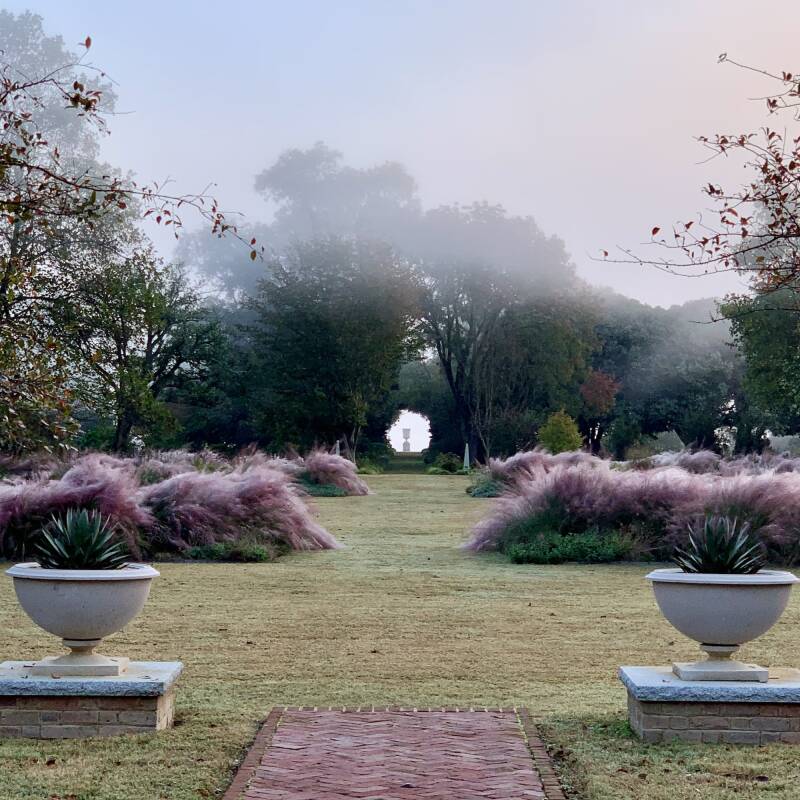If there’s one spot in the middle of nowhere that I’m desperate to visit, it’s Marfa, Texas. You too? Well, allow me to stoke the flames. Last week I had the opportunity to ask landscape architect Christine Ten Eyck a few questions about some of her work there. With the team at her eponymous landscape architect firm, she transformed an abandoned parking lot into The Capri Lounge, a community gathering and event space at Marfa’s Thunderbird Hotel. In Christine’s words: it’s a project that gives hope that any former parking lot can be transformed into a wildlife habitat. Here’s more of what she had to say:

Photo by David Lake.
Above: The Capri Lounge sits across the street from the Thunderbird Hotel. The building and porte cochere on site were designed by Lake | Flato Architects (members of the Remodelista Design Directory and the designers behind Thunderbird Hotel, Hotel San José and Hotel St. Cecilia).

Photo by David Lake.
GD: You’ve described your work as turning “outdoor urban places into ecologically, historically, and contextually sensitive landscapes.” Can you describe how you did that at The Capri?
CT: We are inspired by our clients and their goals, as well as the place and region in which our projects take place. At The Capri, we loved the idea of bringing the incredible grasslands that surround Marfa into town. Elements like our rain water fountain feel like a ranch horse trough. Fire pits and shade structures are made of oil field pipes and farm fencing. Using regional materials ties a new space into the culture of a place. Our client’s vision of this being a community gathering place led us to the design of the courtyards and the beer garden which create a place for community celebrations and events.

Photo by Terrence Moore.
Above: Fire pits made from oil field pipes create gathering spaces.

Photo by Terrence Moore.
GD: How did you face the challenge of turning an abandoned parking lot into an inviting place for guests?
CT: The biggest challenges are finding the right client and contractors”š and we had the best of each. The actual removal of the parking lot was not that difficult. We peeled up the asphalt and tilled the soil below while adding manure from a nearby ranch. We could see the path of storm water across the old parking lot, and this inspired an ephemeral arroyo–Spanish for a dry creek bed–that leads through the new garden to the town creek. Then we nested fire pit islands along the new arroyo. We used gabion walls to create textural enclosure for the courtyards and to screen activity in the courtyard from a neighborhood to the south.

Photo by David Lake.
Above: A shade structure built of reclaimed oil field pipes and farm fencing, and a gabion wall for privacy.

Photo by David Lake.
Above: A water element that evokes regional ranch horse troughs.
GD: We’re intrigued by the water feature. Why did you choose to incorporate it into this space?

Photo by David Lake.
CT: I feel that people need a connection to water, especially those in landlocked, arid areas. I love the ever-changing reflective mirror that water brings to the garden, as well as the psychological cooling.

Photo by Terrence Moore.
CT: The cast in place concrete water trough is a recirculated fountain that harvests rain from half of the roof. We designed a flume that connects to the building gutter and spills into the trough. When it rains, the fountain overflows a weir into a swale that directs the water to the community orchard. It celebrates and makes an event of a badly needed rain shower.

Photo by Terrence Moore.
CT: We used alkali sacaton (Sporobolous airiodes) and bull muhly (Muhlenbergia emersleyi) as our main arroyo grass. In the drier zones, we used side oats and blue grama, Mexican elderberry, aniscanthus, shrubby dogweed, mesquites, desert willow, and apache plume. We used cottonwood closer to the town creek.

Photo by David Lake.
Looking to plant native grasses in your own space? Alkali Sacaton Grass is available for $38 per pound at Great Basin Seeds. A 5-inch pot of bull muhly, also known as El Toro Grass, is available for $9.99 from High Country Gardens.
For more low-water ideas, see A Garden You Water Four Times a Year.
Visit The Capri in Marfa, Texas:








Have a Question or Comment About This Post?
Join the conversation